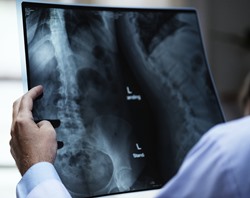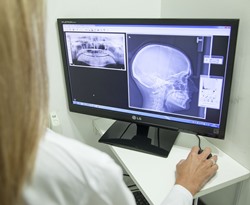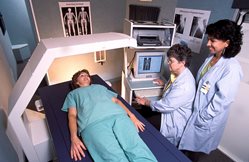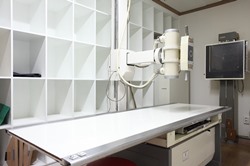How to Find the Right X-Ray Tech Program near Scotland South Dakota
 So you have made the decision to enroll in an X-ray tech school near Scotland SD so you can become a radiologic technician. And now that you have made a decision to enter the rewarding field of healthcare, how do you tackle selecting the right school and program to ensure that you will receive the appropriate training to become a skilled professional? And because most states do mandate that x-ray techs become licensed, depending on where you subsequently practice you may require training to pass a licensing examination. So it’s imperative that you research each of the X-ray technician schools you are looking at so that you can evaluate each program. A number of potential students start by searching for technical schools or colleges that are within driving distance of their residences. Next, they compare tuition and frequently gravitate toward the lowest cost. But while cost and location should be taken into account, there are additional important qualifications also. For instance, you must ask whether or not the radiology tech schools are accredited, or if they offer internship programs. These questions and others you must ask the X-ray Tech schools you are evaluating are provided later in this article. But first, let’s discuss what a radiology technician does and the degrees and education options that are offered.
So you have made the decision to enroll in an X-ray tech school near Scotland SD so you can become a radiologic technician. And now that you have made a decision to enter the rewarding field of healthcare, how do you tackle selecting the right school and program to ensure that you will receive the appropriate training to become a skilled professional? And because most states do mandate that x-ray techs become licensed, depending on where you subsequently practice you may require training to pass a licensing examination. So it’s imperative that you research each of the X-ray technician schools you are looking at so that you can evaluate each program. A number of potential students start by searching for technical schools or colleges that are within driving distance of their residences. Next, they compare tuition and frequently gravitate toward the lowest cost. But while cost and location should be taken into account, there are additional important qualifications also. For instance, you must ask whether or not the radiology tech schools are accredited, or if they offer internship programs. These questions and others you must ask the X-ray Tech schools you are evaluating are provided later in this article. But first, let’s discuss what a radiology technician does and the degrees and education options that are offered.
Radiology Tech Career Description in Scotland SD
 There are multiple professional designations for x-ray techs (technologists or technicians). They may also be referred to as radiologic technologists, radiologic technicians, radiology technicians or radiographers. No matter what the name, each has the same principal job description, which is to use imaging machines to internally view patients for the objective of diagnosis and treatment. A number of radiologic technologists may also provide radiation therapy for treating cancer. Some choose to work as generalists, while others may choose a specialization, for example mammography. They may practice in Scotland SD clinics, hospitals, private practices or outpatient diagnostic imaging centers. The imaging technologies that an X-Ray technologist may utilize include:
There are multiple professional designations for x-ray techs (technologists or technicians). They may also be referred to as radiologic technologists, radiologic technicians, radiology technicians or radiographers. No matter what the name, each has the same principal job description, which is to use imaging machines to internally view patients for the objective of diagnosis and treatment. A number of radiologic technologists may also provide radiation therapy for treating cancer. Some choose to work as generalists, while others may choose a specialization, for example mammography. They may practice in Scotland SD clinics, hospitals, private practices or outpatient diagnostic imaging centers. The imaging technologies that an X-Ray technologist may utilize include:
- Traditional and specialized X-Rays
- Computerized tomography (CT) or “CAT” scans
- Magnetic resonance imaging (MRI)
- Sonography or ultrasound
- Fluoroscopy
Radiographers have to take care of their equipment plus regularly evaluate its functionality and safety. They are additionally required to keep complete records of all of their diagnostic procedures. As medical practitioners, they are held to a high professional standard and code of conduct.
Click Here For Free Information on X-Ray Tech Schools Near You!
X-Ray Technician Degree Options near Scotland SD
 The standard prerequisite for attending a radiology tech college is to have earned a high school diploma or equivalent. Radiologic technologist students have the option to earn either an Associate or a Bachelor’s Degree. An Associate Degree, which is the most common among technicians, generally requires 18 months to two years to finish depending on the course load and program. A Bachelor’s Degree will take longer at up to 4 years to complete and is more extensive in nature. Most students choose a degree major in Radiography, but there are other similar majors that may be acceptable also. Something to consider is that radiographer schools have a practical training or lab component as part of their course of study. It can frequently be fulfilled by participating in an externship program which a large number of colleges sponsor through local hospitals and clinics in Scotland SD or their region. After you have graduated from any of the degree programs, you will need to comply with any licensing or certification mandates in South Dakota or the state you will be working as applicable.
The standard prerequisite for attending a radiology tech college is to have earned a high school diploma or equivalent. Radiologic technologist students have the option to earn either an Associate or a Bachelor’s Degree. An Associate Degree, which is the most common among technicians, generally requires 18 months to two years to finish depending on the course load and program. A Bachelor’s Degree will take longer at up to 4 years to complete and is more extensive in nature. Most students choose a degree major in Radiography, but there are other similar majors that may be acceptable also. Something to consider is that radiographer schools have a practical training or lab component as part of their course of study. It can frequently be fulfilled by participating in an externship program which a large number of colleges sponsor through local hospitals and clinics in Scotland SD or their region. After you have graduated from any of the degree programs, you will need to comply with any licensing or certification mandates in South Dakota or the state you will be working as applicable.
X-Ray Tech Certification and Licensing
When you have graduated from an x-ray technician school, depending on the state where you will be practicing you may need to become licensed. Most states do mandate licensing, and their prerequisites differ so get in touch with your state. Currently, all states that do require licensing will recognize The American Registry of Radiologic Technologists (ARRT) certification examination for the purpose of licensing, but a number offer other alternatives for testing as well. A number of states also call for certification as a component of the licensing process, if not it is optional. However, many Scotland area employers favor hiring radiology techs that have earned certification so it may increase your career options in and around Scotland SD to earn certification. ARRT’s certification program involves graduation from an accepted program as well as a passing score on their rigorous exam. ARRT also calls for re-certification every other year, which may be satisfied with 24 credits of continuing ed, or by passing an examination.
Online Radiology Technician Programs
 As a component of every degree program, x-ray tech schools will have clinical or lab training included in their curriculum. This is the same for online degree colleges. So while you can still earn your online degree, a considerable amount of the training will be satisfied either in a school lab or in an externship off-campus. Practical training is usually performed in Scotland SD family practices, medical clinics or hospitals in sponsorship with the schools. But the online portion of the training can be attended in the privacy of your Scotland home. Students who keep working while earning their degree typically discover that the online approach to education is much more convenient with their busy schedules. Plus online colleges are frequently cheaper than traditional alternatives. In addition to reduced tuition, expenses for study materials and commuting can be reduced as well. But just make sure that the online school you select is accredited (more on the benefits of accreditation later). So if you are disciplined enough to learn with this less formalized type of training, then online classes may be the right option for you.
As a component of every degree program, x-ray tech schools will have clinical or lab training included in their curriculum. This is the same for online degree colleges. So while you can still earn your online degree, a considerable amount of the training will be satisfied either in a school lab or in an externship off-campus. Practical training is usually performed in Scotland SD family practices, medical clinics or hospitals in sponsorship with the schools. But the online portion of the training can be attended in the privacy of your Scotland home. Students who keep working while earning their degree typically discover that the online approach to education is much more convenient with their busy schedules. Plus online colleges are frequently cheaper than traditional alternatives. In addition to reduced tuition, expenses for study materials and commuting can be reduced as well. But just make sure that the online school you select is accredited (more on the benefits of accreditation later). So if you are disciplined enough to learn with this less formalized type of training, then online classes may be the right option for you.
Topics to Ask Radiology Tech Colleges
As soon as you have selected the type of degree that you would like to obtain, you can start the process of searching for and evaluating x-ray technician colleges near Scotland SD. You will also need to decide if you prefer to attend classes online or travel to a local campus. If you choose the latter, then of course the location of the college will be critical. The cost of tuition and supplementary expenses will be a determining variable also. But in addition to location and cost, what more should you factor in when comparing schools? Well, you need to find out if the colleges are accredited, and if they sponsor externship or internship programs. To help you find out some of these important details prior to making your decision, we have compiled a list of questions that you need to ask the programs you are reviewing.
Are the Radiology Technician Colleges Accredited? Most xray technician schools have earned some type of accreditation, whether regional or national. Even so, it’s still imperative to verify that the school and program are accredited. Among the most highly regarded accrediting agencies in the field of radiology is the Joint Review Committee on Education in Radiologic Technology (JRCERT). Programs earning accreditation from the JRCERT have undergone a detailed evaluation of their teachers and course materials. If the college is online it may also obtain accreditation from the Distance Education and Training Council, which focuses on distance or online learning. All accrediting organizations should be acknowledged by the U.S. Department of Education or the Council on Higher Education Accreditation. In addition to ensuring a superior education, accreditation will also help in securing financial assistance and student loans, which are often not offered for non-accredited colleges. Accreditation can also be a pre-requisite for licensing and certification as required. And a number of Scotland SD health facilities will only hire graduates of an accredited college for entry-level openings.
Are Internship Programs Offered? Find out if the xray tech colleges you are assessing have associations with local clinics or hospitals for internship programs. Not only are internships a great way to obtain hands on experience in a clinical setting, they are additionally a means to satisfy the clinical training requirement for the majority of programs. As an ancillary benefit, they can assist graduates and students form professional connections in the Scotland SD healthcare community and assist with job placement.
Is Job Placement Help provided? You will undoubtedly want to hit the ground running after graduation, but finding that first job in Scotland SD in a new profession can be challenging without support. Ask if the x-ray tech schools you are reviewing have job assistance programs and what their placement rates are. High and rapid placement rates are an excellent indication that the schools have large networks and great relationships with South Dakota healthcare employers. It also confirms that their graduates are highly regarded and sought after.
Where is the Program Located? For a lot of students, the school they pick will have to be within driving distance of their Scotland SD residence. Those who have opted to attend classes online obviously will not have to concern themselves with the location of the campus. However, the availability of area internships will be of concern. One thing to keep in mind is that if you choose to enroll in a program that is out of state or even out of your local area, you may have to pay a higher tuition. State colleges typically charge higher tuitions for out of state residents. And community colleges often charge a higher tuition for those students that don’t reside within their districts.
How Big are the Classes ? Unless you are the sort of student that likes to sit way in the back of class or hide in the crowd, you will probably prefer a smaller class size. Small classes allow for more individual participation and personalized instruction. Ask the Scotland SD colleges you are looking at what the typical teacher to student ratio is for their classes. If practical you may prefer to monitor one or more classes before making your final decision. This will also give you an opportunity to speak with some of the instructors and students to get their perspectives regarding the xray technician program as well.
Can the Program Accommodate your Schedule? And last you must verify that the xray tech program you finally pick can offer the class schedule you need. This is especially essential if you choose to continue working while you attend school. If you must schedule night or weekend classes in the Scotland SD area, verify that they are offered. If you can only enroll on a part-time basis, check if that is an alternative and how many courses or credit hours you would have to enroll in. Also, find out what the procedure is for making up any classes that you may miss as a result of work, illness or family emergencies.
How to Enroll in Weekend X Ray Technician Schools Scotland SD
 Enrolling in the right x-ray tech school is a crucial first step toward beginning a satisfying new career furnishing diagnostic medical services to patients. The ideal radiologic technologist should be in good physical condition. Radiology techs regularly stand for the greater part of the workday and position and in some cases lift the patient to obtain the correct image. Candidates must also show a capability to pay strict attention to detail and to follow the safety requirements developed to protect both the patient and the medical team. X-Ray techs work very closely with patients, other techs as well as the radiologists and other doctors. Having interpersonal skills is a necessity in order to have a productive work environment and deliver the best possible patient care. You originally came to this website due to an interest in How to Enroll in Weekend X Ray Technician Schools and wanting more information on the topic Top Part Time Radiology Technician Schools. However, as we have addressed in this report, there are a number of questions that you need to ask each school you are assessing prior to making your ultimate selection. This is similarly true whether you decide on an online program or travel to classes on campus. By asking the appropriate questions you can evaluate and compare each college so you can focus your choices and make your final choice. And with the right education and your motivation to succeed, you can realize your goal to work as a radiologic technologist in Scotland SD.
Enrolling in the right x-ray tech school is a crucial first step toward beginning a satisfying new career furnishing diagnostic medical services to patients. The ideal radiologic technologist should be in good physical condition. Radiology techs regularly stand for the greater part of the workday and position and in some cases lift the patient to obtain the correct image. Candidates must also show a capability to pay strict attention to detail and to follow the safety requirements developed to protect both the patient and the medical team. X-Ray techs work very closely with patients, other techs as well as the radiologists and other doctors. Having interpersonal skills is a necessity in order to have a productive work environment and deliver the best possible patient care. You originally came to this website due to an interest in How to Enroll in Weekend X Ray Technician Schools and wanting more information on the topic Top Part Time Radiology Technician Schools. However, as we have addressed in this report, there are a number of questions that you need to ask each school you are assessing prior to making your ultimate selection. This is similarly true whether you decide on an online program or travel to classes on campus. By asking the appropriate questions you can evaluate and compare each college so you can focus your choices and make your final choice. And with the right education and your motivation to succeed, you can realize your goal to work as a radiologic technologist in Scotland SD.
Other South Dakota Diagnostic Locations
£sd
£sd (occasionally written Lsd, spoken as "pounds, shillings and pence" or pronounced /ɛlɛsˈdiː/ ell-ess-DEE) is the popular name for the pre-decimal currencies once common throughout Europe, especially in the British Isles and hence in several countries of the British Empire and subsequently the Commonwealth. The abbreviation originates from the Latin currency denominations librae, solidi, and denarii.[1] In the United Kingdom, which was one of the last to abandon the system, these were referred to as pounds, shillings, and pence (pence being the plural of penny).
This system originated in the classical Roman Empire. It was re-introduced into Western Europe by Charlemagne, and was the standard for many centuries across the continent. In Britain, it was King Offa of Mercia who adopted the Frankish silver standard of librae, solidi and denarii in the late 8th century,[2] and the system was used in much of the British Commonwealth until the 1960s and 1970s, with Nigeria being the last to abandon it in the form of the Nigerian pound on 1 January 1973.
Under this system, there were 12 pence in a shilling and 20 shillings, or 240 pence, in a pound. The penny was subdivided into 4 farthings until 31 December 1960, when they ceased to be legal tender in the UK, and until 31 July 1969 there were also halfpennies ("ha'pennies") in circulation. The perceived advantage of such a system was its use in some aspects of mental arithmetic, as it afforded many factors and hence fractions of a pound such as tenths, eighths, sixths and even sevenths and ninths if the guinea (worth 21 shillings) was used. When dealing with items in dozens, multiplication and division are straightforward; for example, if a dozen eggs cost four shillings, then each egg was priced at fourpence. Basic addition, however, could be more difficult than using a decimal system.
